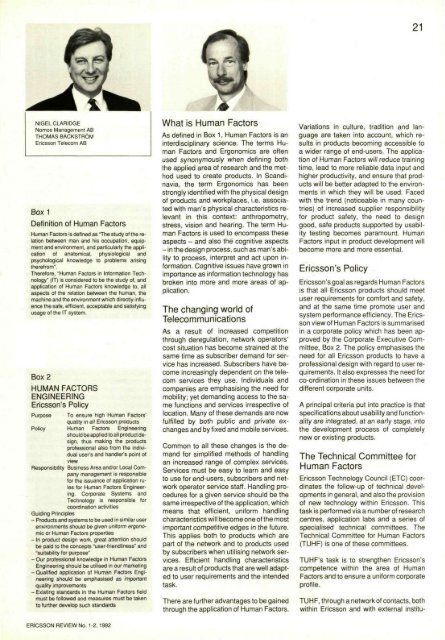Frame Relay - for Faster and More Efficient Data Communications ...
Frame Relay - for Faster and More Efficient Data Communications ...
Frame Relay - for Faster and More Efficient Data Communications ...
- No tags were found...
Create successful ePaper yourself
Turn your PDF publications into a flip-book with our unique Google optimized e-Paper software.
21NIGEL CLARIDGENomos Management ABTHOMAS BACKSTROMEricsson Telecom ABBox 1Definition of Human FactorsHuman Factors is defined as "The study of the relationbetween man <strong>and</strong> his occupation, equipment<strong>and</strong> environment, <strong>and</strong> particularly the applicationof anatomical, physiological <strong>and</strong>psychological knowledge to problems arisingtherefrom".There<strong>for</strong>e, "Human Factors in In<strong>for</strong>mation Technology"(IT) is considered to be the study of, <strong>and</strong>application of Human Factors knowledge to, allaspects of the relation between the human, themachine <strong>and</strong> the environment which directly influencethe safe, efficient, acceptable <strong>and</strong> satisfyingusage of the IT system.Box 2HUMAN FACTORSENGINEERINGEricsson's PolicyPurpose To ensure high Human Factors'quality in all Ericsson productsPolicy Human Factors Engineeringshould be applied to all product design,thus making the productsprofessional also from the individualuser's <strong>and</strong> h<strong>and</strong>ler's point ofviewResponsibility Business Area <strong>and</strong>/or Local Companymanagement is responsible<strong>for</strong> the issuance of application rules<strong>for</strong> Human Factors Engineering.Corporate Systems <strong>and</strong>Technology is responsible <strong>for</strong>coordination activitiesGuiding Principles- Products <strong>and</strong> systems to be used in similar userenvironments should be given uni<strong>for</strong>m economicor Human Factors properties- In product design work, great attention shouldbe paid to the concepts "user-friendliness" <strong>and</strong>"suitability <strong>for</strong> purpose"- Our professional knowledge in Human FactorsEngineering should be utilised in our marketing- Qualified application of Human Factors Engineeringshould be emphasised as importantquality improvements- Existing st<strong>and</strong>ards in the Human Factors fieldmust be followed <strong>and</strong> measures must be takento further develop such st<strong>and</strong>ardsERICSSON REVIEW No. 1-2,1992What is Human FactorsAs defined in Box 1, Human Factors is aninterdisciplinary science. The terms HumanFactors <strong>and</strong> Ergonomics are oftenused synonymously when defining boththe applied area of research <strong>and</strong> the methodused to create products. In Sc<strong>and</strong>inavia,the term Ergonomics has beenstrongly identified with the physical designof products <strong>and</strong> workplaces, i.e. associatedwith man's physical characteristics relevantin this context: anthropometry,stress, vision <strong>and</strong> hearing. The term HumanFactors is used to encompass theseaspects - <strong>and</strong> also the cognitive aspects- in the design process, such as man's abilityto process, interpret <strong>and</strong> act upon in<strong>for</strong>mation.Cognitive issues have grown inimportance as in<strong>for</strong>mation technology hasbroken into more <strong>and</strong> more areas of application.The changing world ofTelecommunicationsAs a result of increased competitionthrough deregulation, network operators'cost situation has become strained at thesame time as subscriber dem<strong>and</strong> <strong>for</strong> servicehas increased. Subscribers have becomeincreasingly dependent on the telecomservices they use. Individuals <strong>and</strong>companies are emphasising the need <strong>for</strong>mobility; yet dem<strong>and</strong>ing access to the samefunctions <strong>and</strong> services irrespective oflocation. Many of these dem<strong>and</strong>s are nowfulfilled by both public <strong>and</strong> private exchanges<strong>and</strong> by fixed <strong>and</strong> mobile services.Common to all these changes is the dem<strong>and</strong><strong>for</strong> simplified methods of h<strong>and</strong>lingan increased range of complex services.Services must be easy to learn <strong>and</strong> easyto use <strong>for</strong> end-users, subscribers <strong>and</strong> networkoperator service staff. H<strong>and</strong>ling procedures<strong>for</strong> a given service should be thesame irrespective of the application, whichmeans that efficient, uni<strong>for</strong>m h<strong>and</strong>lingcharacteristics will become one of the mostimportant competitive edges in the future.This applies both to products which arepart of the network <strong>and</strong> to products usedby subscribers when utilising network services.<strong>Efficient</strong> h<strong>and</strong>ling characteristicsare a result of products that are well adaptedto user requirements <strong>and</strong> the intendedtask.There are further advantages to be gainedthrough the application of Human Factors.Variations in culture, tradition <strong>and</strong> languageare taken into account, which resultsin products becoming accessible toa wider range of end-users. The applicationof Human Factors will reduce trainingtime, lead to more reliable data input <strong>and</strong>higher productivity, <strong>and</strong> ensure that productswill be better adapted to the environmentsin which they will be used. Facedwith the trend (noticeable in many countries)of increased supplier responsibility<strong>for</strong> product safety, the need to designgood, safe products supported by usabilitytesting becomes paramount. HumanFactors input in product development willbecome more <strong>and</strong> more essential.Ericsson's PolicyEricsson's goal as regards Human Factorsis that all Ericsson products should meetuser requirements <strong>for</strong> com<strong>for</strong>t <strong>and</strong> safety,<strong>and</strong> at the same time promote user <strong>and</strong>system per<strong>for</strong>mance efficiency. The Ericssonview of Human Factors is summarisedin a corporate policy which has been approvedby the Corporate Executive Committee,Box 2. The policy emphasises theneed <strong>for</strong> all Ericsson products to have aprofessional design with regard to user requirements.It also expresses the need <strong>for</strong>co-ordination in these issues between thedifferent corporate units.A principal criteria put into practice is thatspecifications about usability <strong>and</strong> functionalityare integrated, at an early stage, intothe development process of completelynew or existing products.The Technical Committee <strong>for</strong>Human FactorsEricsson Technology Council (ETC) coordinatesthe follow-up of technical developmentsin general, <strong>and</strong> also the provisionof new technology within Ericsson. Thistask is per<strong>for</strong>med via a number of researchcentres, application labs <strong>and</strong> a series ofspecialised technical committees. TheTechnical Committee <strong>for</strong> Human Factors(TUHF) is one of these committees.TUHF's task is to strengthen Ericsson'scompetence within the area of HumanFactors <strong>and</strong> to ensure a uni<strong>for</strong>m corporateprofile.TUHF, through a network of contacts, bothwithin Ericsson <strong>and</strong> with external institu-















